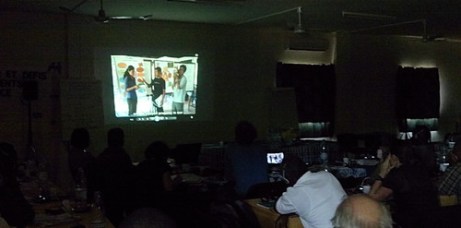At an international conference for African communities facing land-grabbing, LICADHO presented a video showing how communities in Cambodia are resisting forced evictions and land grabbing. The three-day conference, Land grabbing in Africa – Dangers and Challenges, was hosted by Caritas Senegal in cooperation with other groups like, FIAN – that is FoodFirst Information and Action Network.
The video is a great example of remixing: re-using existing footage and, in this case, adding tailored footage to serve the target audience. Given the tight timeline, there was no need to edit a new introductory segment describing forced evictions in the Cambodian context, when existing footage already served this purpose. Watch LICADHO’s video and see what I mean.
LICADHO staff in Cambodia worked long hours editing and re-editing the video – basically up to the very last minute. Uploading in Cambodia and downloading in Senegal an 8-minute video was an exercise in extreme patience for all of us. Unfortunately, due to illness, a LICADHO representative could not make the trip from Cambodia, however Jason Barber, who served as a consultant with LICADHO for many years, happened to be in not-exactly-nearby Uganda.
From where I was participating in the World Social Forum, the conference was actually 2 hours away from Dakar. (I was told only 1 hour away – so glad I left early!) I hustled down to the conference just in time for the presentation. After the Q&A, I turned right around a went back to Dakar.
The presentation and video sparked active debate among the participants about how to translate tactics from Cambodia to respective countries in Africa. Several times it was said that the actions of Cambodian communities against forced evictions and land-grabbing were inspiring to communities facing similar threats in Africa.
Seeing the tactics employed in Cambodia, participants in Africa could do their own practical application to their own struggles. I can not imagine this translation being as dynamic without the video examples provided by LICADHO.
Thank you LICADHO for sharing the actions of communities in Cambodia as positive examples of resistance to land-grabbing!



Hi Jonathan – thanks for your comment. You already may be familiar with the Holocaust Museum’s use of mapping Darfur http://www.ushmm.org/maps/ the use of the Ushahidi platform to map Kibera http://voiceofkibera.org/ and the use of Google Earth to show the effects on humans and environment in the Amazon as a result of the planned Bel Monte dam
.
Definitely, mapping can really aid advocacy for forced evictions, especially since the rights at stake are often physical – land, water, housing, environment – and therefore, can be physically visualized on a map. We are thinking about how mapping could be integrated into our global campaign on forced evictions.
What could be very interesting, as you mention, is to use maps to visualize the effects of forced eviction over a period of time. In addition, it could really benefit the larger campaign, to show on a map how these projects – locally and globally – are linked together through similar businesses and business practices; funding sources (World Bank, Asian Dev’t Bank); development projects (mega-events like the Olympics, World Cup); industries (mining, dams); and national and local government policies. This broader narrative, I think, could really aid activists and policy makers to connect the broader, systemic nature behind the projects that cause forced evictions in the first place.
Yes, the video brings the context of the problem over much faster than a static report, radio show or a series of photos would have done. Faster for people to grasp and then discuss ways in which what they have just seen is relevant to their situation.
Have you had any experience of using maps? I find that Google Earth (and streetview) is starting to act as a catalyst during the discussion – what needs to change or understanding what the impact of new buildings would be on the environment…